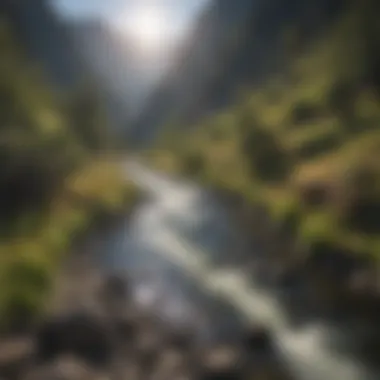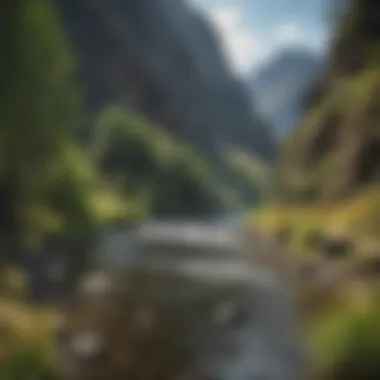Exploring Hells Canyon: Geological and Ecological Insights


Intro
Hells Canyon is not just another pretty picture on a postcard; it’s a testament to the Earth’s geological history and an intricate web of life that thrives within its rugged embrace. Nestled along the Snake River, this canyon stands as one of North America's deepest, drawing visitors with its breathtaking vistas and intriguing biodiversity. The place offers more than mere sightseeing. It encapsulates a rich tapestry of historical narratives intertwined with nature, echoing centuries of human interaction.
Through this article, we will embark on a journey to peel back the layers of Hells Canyon, revealing its ecological significance, geological mysteries, and the countless ways that people have engaged with this dramatic landscape.
By taking a closer look at the canyon’s formation, its ecological features, and the cultural touches left by those who walked its paths, we aim to illuminate not just its beauty, but also the pressing need for conservation in such vital landscapes.
Understanding Woodland Ecosystems
Importance of Biodiversity in Forests
Biodiversity isn’t merely a buzzword; it’s a cornerstone of woodland ecosystems. Hells Canyon's diverse plant and animal life plays an essential role in maintaining ecological balance. From towering Douglas firs to the delicate wildflowers dotting the canyon floor, each organism contributes to the intricate web of life. In this region, the flora provides habitat and nourishment for various species, while also participating in essential processes like pollination.
The variety of life forms creates resilience. This ecosystem can withstand disturbances like droughts or pests better than monocultures, where a single species prevails. When you take a step back, the importance of biodiversity becomes evident—not just for the woods, but for the entire planet’s health.
Role of Forests in Climate Regulation
Forests act as significant players in the fight against climate change. They absorb carbon dioxide, acting as natural sponges. In regions like Hells Canyon, the abundant trees and underbrush help offset greenhouse gases, a crucial task in today’s warming world.
But that’s not all. These forests play a role in regulating local climates, fostering rainfall, and maintaining cooler temperatures in the surrounding areas. As the climate shifts, understanding and preserving these ecosystems could be more vital than ever.
Sustainable Forestry Practices
Principles of Sustainable Forestry
When it comes to forestry in Hells Canyon, sustainability isn't just a goal; it's a necessity. The principles of sustainable forestry involve practices that not only support the current forest population but also ensure its health for future generations. Key practices include selective logging, reforestation, and minimizing the impact of roads and infrastructure on the natural landscape.
Emphasis on ecological health, economic viability, and social equity informs sustainable practices—keep the forest thriving, support local economies, and respect the cultural connections people have with the land. In a region like Hells Canyon, these principles are not just theoretical; they shape the lived experience of the community.
Case Studies of Successful Implementations
It's one thing to talk about sustainable practices, but seeing them in action paints a clearer picture. Several areas in the Hells Canyon region have embraced forward-thinking approaches that yield positive results. For instance, collaborative forest management initiatives have emerged, where local stakeholders come together to identify the best strategies for resource use and conservation.
By engaging with indigenous groups, conservationists, and timber companies, these case studies showcase how mixed interests can come together to protect these precious landscapes. This cooperation often leads to more effective stewardship, enabling both human and ecological communities to thrive together.
Woodland Stewardship Techniques
Forest Management Plans
Creating a robust forest management plan requires a thoughtful approach that combines scientific understanding with local knowledge. In Hells Canyon, these plans often outline strategies for regeneration, wildlife habitat enhancement, and community participation in monitoring forest health.
These plans are vital in addressing issues like invasive species management and the risks of forest fires, paving the way for healthier woodlands.
Conservation Strategies
Conservation strategies in Hells Canyon must adapt to the unique challenges presented by its diverse landscapes. Initiatives can include habitat restoration projects and the establishment of conservation easements to protect natural areas from development.
Efforts to involve local communities in stewardship practices foster a sense of responsibility and connection to the land.
"Protecting Hells Canyon isn't just about preserving a natural wonder; it's about ensuring that future generations can connect with, learn from, and enjoy this magical place."
This nexus of community involvement, ecological health, and strategic planning makes Hells Canyon a beacon for those looking to understand and implement meaningful conservation efforts.
End
As we journey deeper into Hells Canyon, the interplay of forces at work—geological, ecological, and cultural—becomes increasingly evident. This region stands not only as a witness to the passage of time but also as a crucial player in the ongoing dialogue about environmental stewardship, sustainability, and the future of our natural resources.
Prolusion to Hells Canyon
Hells Canyon stands as a testament to the Earth’s raw beauty and complex geology. Located along the border of Oregon and Idaho, this canyon is not just a dramatic landscape, but also a vital ecological and cultural treasure. It has been shaped over millennia by the winding efforts of the Snake River, one of the longest rivers in the United States. In this section, we will unravel the geographical features and significance of the Snake River, both of which continue to play a pivotal role in understanding the essence of Hells Canyon.
Geographical Overview
Hells Canyon stretches approximately 10 miles across and plunges more than a mile deep, making it the deepest river gorge in North America. This striking depth and its sheer cliffs give it an almost otherworldly atmosphere. The diverse landscape ranges from rugged mountains adorned with conifers to lower elevations populated by sagebrush and wildflowers. The canyon runs between the Seven Devils Mountains in Idaho to the east and the Wallowa Mountains in Oregon to the west, creating a dramatic topographical contrast.
The Snake River, coursing through this dramatic canyon, originates from the western slopes of the Tetons in Wyoming, traveling over a vast distance to carve through the rugged terrains of Idaho and Oregon. The river’s interaction with the geological formations leads to varied and unique microclimates within the canyon, which in turn support an astounding variety of flora and fauna. Understanding this geographical layout is crucial for appreciating not only the scenic beauty of Hells Canyon but also its ecological dynamics.
Significance of the Snake River
The Snake River is the lifeblood of Hells Canyon. Without it, much of what makes this canyon remarkable would be a mere shadow of its current self. The river's relentless flow has sculpted the canyon walls, depositing sediment and shaping the landscapes into the awe-inspiring formations we see today. It also acts as a crucial water source for both the ecosystems present in the canyon and the human communities that have long inhabited the area.
Moreover, the river serves as a corridor for wildlife movement and biodiversity. Species like salmon and steelhead rely on its waters for spawning, creating a rich connection between the aquatic and terrestrial worlds. The diversity of habitats along the river—from riparian zones to uplands relevant for bird nesting—demonstrates the Snake River's significance as an ecological resource.
"The Snake River is more than just water. It’s the thread weaving together the distinct tapestry of life in Hells Canyon."
Hells Canyon’s rich history is also intertwined with the river’s currents. Throughout the ages, various human societies have depended on the Snake River for sustenance, trade, and spirituality. From indigenous tribes, who viewed it as sacred, to early pioneers, who navigated its waters, the river has been central to human interaction with this striking landscape.
As we move forward in our exploration, understanding the geographical features and the crucial role played by the Snake River is essential. These elements lay the groundwork for delving deeper into the geological, ecological, and cultural dimensions of Hells Canyon.
Geological Formation
The geological formation of Hells Canyon is not only a testament to the earth's dynamic processes but also a key to understanding the broader ecological and cultural tapestry that this region presents. Hells Canyon, carved by the Snake River, showcases the intricate interplay of tectonic movements and erosion, which has sculpted its awe-inspiring landscape over millions of years. This section delves into these elements, providing a comprehensive understanding of how this magnificent canyon came to be.
Tectonic Activity


The dramatic cliffs and unique valleys of Hells Canyon can be traced back to tectonic activity, which has played a crucial role in shaping its current form. Situated in the Pacific Northwest, this region is influenced by the continental collision of several tectonic plates. These movements, primarily the subduction of the Juan de Fuca plate beneath the North American plate, happen at a crawl but with immense power behind them.
As these massive rock slabs shift, they create stress within the earth's crust, leading to faulting and lifting of geological formations around Hells Canyon. This process has resulted in the steep gradients and rugged terrain found throughout the canyon landscapes. Significant features, such as the Seven Devils Mountains, rise dramatically from the valley floors, a testament to the uplifting forces of tectonics at play.
In summary,
- Tectonic uplift has contributed to the canyon's depth and steepness.
- Plate movements have forced ancient rocks to surface, exposing geological wonders linked to Hells Canyon's history.
Erosion Processes
Once the foundational layers were set by tectonic activity, erosion began to carve out what we now recognize as Hells Canyon. Several factors are at play in this ongoing process. The powerful Snake River, continually flowing through the canyon, serves as the primary agent of erosion. Over time, it has effectively removed vast quantities of earth, revealing the diverse strata of rock beneath.
Besides the river, other elements contribute significantly to erosion:
- Weathering from wind and rain contributes to gradual breakdown of the rock surfaces.
- Freezing and thawing cycles cause rocks to crack and break apart.
- Vegetation growth also plays a role; while roots can stabilize soil, they can also crack and alter rock formations.
These combined processes have created a landscape that is not only striking but also varied, with a mosaic of different rock types and deep gorges interspersed with extensive fluvial systems. The erosion of Hells Canyon continues to be an essential aspect of its ongoing geological evolution and influences its ecology.
Rock Types and Structures
Hells Canyon boasts an impressive array of rock types, each telling a part of the canyon's geological story. The age and composition of these rocks vary, illustrating the region's complex geological history. Among the most prevalent rock types found in the area are:
- Basalt, a volcanic rock formed from ancient lava flows that created the canyon's flat-topped ridges. This dark rock is crucial in the formation of many steep cliffs.
- Granite, known for its strength and durability, can be seen under the wear of erosion, standing as prominent outcrops.
- Sedimentary rocks, such as sandstone and limestone, lie within the canyon walls, often hosting fossils that date back millions of years.
The layering of these different rock types provides insight into past environments, climate changes, and even the biological history of the region. Distinctives structures, such as the imposing sheer cliffs and deep gorges, reflect not only the history of volcanic activity but also the immense power of water that has shaped the canyon over the eons.
Biodiversity in Hells Canyon
The biodiversity of Hells Canyon plays a crucial role in understanding not just the unique ecosystems that thrive there, but also the overall health of the region. This diversity, encompassing both flora and fauna, contributes to the resilience of environmental systems and sustains a variety of life forms that rely upon one another. In Hells Canyon, the interplay of various species helped maintain ecological balance while offering opportunities for study and enjoyment, particularly for forestry professionals and academics. The sheer variety of organisms adapts to the area's harsh conditions, serving as a testament to nature's ingenuity.
Flora of Hells Canyon
The plant life of Hells Canyon is incredibly diverse, showcasing a model of ecological adaptation. Different zones within the canyon support various species, from hardy wildflowers sprouting in rocky crevices to towering conifer trees gracing higher elevations. Among the notable species is the ponderosa pine, which thrives in the drier, warmer southwestern regions of the canyon, providing shelter and resources for countless creatures.
Some key characteristics of the flora include:
- Adaptation to Elevation: Many plants exhibit vertical zonation based on altitude, with unique species occupying specific niches.
- Phenological Diversity: Seasonal changes influence flowering and seed germination, allowing different species to thrive at various times of the year.
Researching the flora within Hells Canyon not only enhances our understanding of plant ecology but highlights the significance of plant species in maintaining surrounding habitats.
Fauna of Hells Canyon
When it comes to wildlife, Hells Canyon is home to a rich array of animal species that use the canyon's various habitats for shelter and sustenance. This includes everything from deer and elk grazing on the lush underbrush to mountain goats climbing the rugged cliffs.
Key details about the fauna of Hells Canyon include:
- Niche Specialization: Different species occupy distinct ecological roles, which supports the overall function of the ecosystem.
- Endangered Species: Some species, like the bald eagle, have made a comeback in this area, emphasizing the success of conservation efforts.
The health and diversity of animal life tell a compelling story of adaptation and survival in an environment shaped by both natural and human forces.
Unique Ecosystems
Hells Canyon boasts a range of unique ecosystems, each contributing to the region's ecological richness.
Riparian Zones
Riparian zones are critical transitional areas between aquatic and terrestrial environments. These regions, nestled along the banks of the Snake River, are notably rich in biodiversity. Key characteristics of riparian zones include:
- Nutrient-Rich Soils: These areas often have higher soil fertility, supporting diverse plant life that in turn attracts various wildlife.
- Water Availability: Proximity to water sources sustains life and allows for unique adaptations.
The presence of these zones makes it a vital choice for conservation efforts in Hells Canyon. They provide habitat for numerous species while aiding in flood control and improving water quality. However, they also face threats from invasive species and human encroachment.
Mountain Ecosystems
The mountain ecosystems of Hells Canyon provide another layer of biological complexity. These areas, characterized by steep slopes and elevated terrain, exhibit features such as:
- Microclimatic Variation: Different altitudes and exposures create varying climates, fostering diverse plant communities.
- Wildlife Corridors: These ecosystems function as corridors, allowing species to migrate and maintain genetic diversity.
Recognizing the importance of these ecosystems enhances our ability to manage and conserve biodiversity effectively. Such regions can be sensitive to climate change, and protecting them is essential.
Desert-like Regions
Finally, the desert-like areas of Hells Canyon reveal intriguing adaptations in both flora and fauna. This ecosystem features:
- Drought Resilience: Species here have developed remarkable mechanisms to survive with minimal water.
- Unique Flora: Cacti and other succulents thrive within this harsh environment, showcasing an amazing natural resilience.
This underappreciated ecosystem holds potential for new discoveries; studying its adaptive strategies can provide insights into how life thrives in extreme conditions. However, like other ecosystems in Hells Canyon, it faces challenges from climate shifts and human activities, making its conservation imperative.
Understanding the unique ecosystems within Hells Canyon is vital to appreciating the interdependence of species and their environments, and serves as a call to action for sustainable management practices.
Cultural History
Understanding the cultural history of Hells Canyon is crucial, as it sheds light on the intertwined relationship between humans and this magnificent natural landscape. The region is a tapestry woven with the stories of its Indigenous peoples, the advent of explorers, and the subsequent settlement initiatives. Each of these epochs has left an indelible mark, contributing to the multifaceted identity that Hells Canyon embodies today.
Indigenous Cultures


Hells Canyon is home to rich Indigenous cultures, primarily the Nez Perce and Shoshone tribes. These communities have thrived here for thousands of years, utilizing the canyon’s resources for sustenance, spirituality, and social structures.
The Snake River has been a lifeline for these peoples. They fished its waters, hunted the surrounding lands, and foraged the diverse plant life, ensuring their survival in this rugged environment. They viewed the canyon not merely as a geographical feature but as a sacred entity, a living part of their heritage.
Older stories abound, listening to the past can reveal ancient fishing practices, the significance of seasonal migrations, and how the landscape shaped their cultural narratives. Understanding these aspects reminds us that this land is not just a backdrop; it is the essence of their identity.
Exploration and Settlement
As European explorers ventured into the region during the 19th century, the dynamics shifted remarkably. Figures such as Lewis and Clark, motivated by curiosity and ambition, navigated the wild terrains. Their journeys prompted further exploration, leading to the influx of settlers drawn by the lure of untapped resources and the promise of prosperity.
Notably, the Oregon Trail, a vital passage for countless pioneers, ran nearby. This path would deeply influence the settlement of Hells Canyon and surrounding areas. Towns sprang up, and agriculture flourished and thrived as settlers sought to carve a life out of the rugged wilderness.
However, this settlement also led to challenges and conflicts with Indigenous peoples, resulting in a tumultuous period where cultural heritage was sometimes overshadowed by expansion and ownership.
Historical Land Use
Over the years, Hells Canyon has been subjected to various land uses that have transformed its landscape. Farming and livestock grazing emerged as primary activities facilitated by settlers.
- The fertile valleys around the Snake River were turned into agricultural lands, supporting various crops.
- Grazing by cattle herds altered the natural dynamics of the ecosystem, impacting both flora and fauna.
The construction of dams and irrigation projects in the 20th century aimed to harness the Snake River’s power, providing electricity and flood control. However, these ventures often compromised natural habitats, altering water flow and disrupting traditional fish populations crucial for the Indigenous cultures.
The historical interactions between land use, economic incentives, and cultural preservation continually shape our understanding of Hells Canyon today.
"To understand the history of Hells Canyon is to recognize the stories and struggles intertwined within its rugged beauty. Each layer, from Indigenous traditions to modern dynamics, reveals the complexity of human interactions with nature."
The exploration of Hells Canyon's cultural history emphasizes the necessity of acknowledging past narratives while contemplating future management and conservation efforts. Only then can we begin to fully appreciate the rich heritage that informs the ongoing dialogue between humans and this remarkable natural wonder.
Recreation and Tourism
Recreation and tourism play a pivotal role in the value and identity of Hells Canyon, with its rugged landscapes and varied wildlife continuously drawing visitors to the area. The sheer natural beauty, coupled with the opportunity to engage in an array of outdoor activities, ensures that this location remains a significant destination for both thrill-seekers and those simply looking to appreciate nature's splendor. Not only does it provide a recreational haven, but it also bolsters the local economy and fosters a communal respect for the region's natural habitat.
Outdoor Activities
Outdoor activities constitute the backbone of what makes Hells Canyon an appealing place for many. Whether on foot, water, or simply observing from a distance, these activities allow individuals to connect intimately with nature.
Hiking Trails
Hiking trails in Hells Canyon map a wealth of experiences for enthusiasts. The winding pathways not only challenge your physical limits but also provide breathtaking views of the canyon's cliffs and the Snake River far below. A standout feature of these trails is that they cater to all skill levels—offering options for seasoned trekkers and beginners alike.
One well-trodden trail, the Hells Canyon Rim Trail, features stunning overlooks that allow sightseers to witness the grandeur of this landscape. That said, potential hikers should consider the fluctuations in weather and trail conditions, particularly during the spring melt. Navigating carefully can guarantee a fulfilling hike without unnecessary risks.
Boating on the Snake River
The Snake River itself is a gem for boating aficionados. The river's currents vary, providing opportunities for both calm floats and exhilarating whitewater challenges. Exploring the canyon from this unique vantage point enhances the overall experience, revealing majesty in the rocks and wildlife that is hard to grasp from land. The Hells Canyon National Recreation Area is known for its stunning scenery seen only from the river.
However, safety should remain a top priority. With rapid current changes and varying water levels, it's vital for boaters to remain informed about conditions and regulations before embarking on their adventure. Proper equipment and local knowledge can make or break a trip down the river.
Wildlife Observation
Wildlife observation in Hells Canyon is an enriching experience that brings visitors closer to the natural inhabitants of this region. With species such as elk, deer, and various birds at play, there’s always something to catch the eye. Resorting to early morning or dusk hours increases the likelihood of spotting these remarkable creatures as they come alive in their natural habitat.
The area’s astounding diversity presents an opportunity for enthusiasts—both amateur and seasoned—to immerse themselves in the wild’s intricacies. Nonetheless, observing wildlife requires patience and respect for their environments, ensuring that neither animals nor their habits are disturbed.
Impact of Tourism
Tourism undeniably impacts Hells Canyon, for better or worse. While it brings economic support and opportunities to the local community, it also poses challenges in terms of conservation and the preservation of ecological integrity. Maintaining a balance between tourist influx and nature's well-being remains essential to ensuring that future generations can enjoy this unique environment.
Sustainable Tourism Practices
Sustainable tourism practices are increasingly crucial as the popularity of Hells Canyon skyrockets. Emphasizing low-impact visits, such as utilizing structured trails and responsible boat use, helps mitigate the ecosystem’s stressors.
Adopting practices that prioritize local culture, preservation, and community involvement can pave the way for tourism that contributes positively rather than detracting from the canyon's environment. For those eager to contribute positively while enjoying natural wonders, making conscious choices regarding activities can merge leisure with stewardship, ensuring the longevity of Hells Canyon as both a cultural and environmental landmark.
"To truly appreciate Hells Canyon, one must walk the trails, float the waters, and take part in its diverse life."
With thoughtful engagement and respect for Hells Canyon's natural resources, visitors can build a legacy that honors the past and nurtures the future.
Conservation Efforts
Conservation efforts in Hells Canyon are critical to preserving its unique ecosystems and the rich tapestry of biodiversity found within its confines. As one of the deepest canyons in North America, Hells Canyon harbors numerous plant and animal species, some of which are in need of protection due to changing environmental conditions and human activities. Effective conservation initiatives not only aim to safeguard these species but also ensure that future generations can enjoy the canyon’s stunning natural beauty and resources. The multifaceted approach to conservation here reverberates with the emphasis on sustainable practices while addressing pertinent issues such as climate change, habitat degradation, and the encroachment of invasive species.
Protected Areas
In the context of Hells Canyon, several protected areas play a pivotal role in the preservation of its diverse wildlife and flora. Key among these is the Hells Canyon National Recreation Area, which offers a refuge for a variety of plants and animals, including rare species that thrive in this unique environment. Managed by the USDA Forest Service, this recreational area provides not just protection for the ecosystem but also opportunities for educational activities and responsible tourism, inviting visitors to connect with nature without jeopardizing its delicate balance.
The establishment of protected areas is essential for maintaining biodiversity and ecological resilience.
Moreover, other conservation units, like the Oregon State Parks and Idaho’s land management systems, work together to bolster efforts in habitat preservation and ecological research. These areas are vital for monitoring the health of ecosystems, restoring natural habitats, and serving as benchmarks for effective land use practices. By prioritizing protected regions, conservationists provide sanctuaries where native species can thrive unimpeded by human interference.
Restoration Projects
Restoration projects in Hells Canyon focus on rehabilitation of damaged ecosystems, especially where human activity has taken a toll. These initiatives may include replanting native vegetation, controlling invasive species, and rehabilitating waterways to improve water quality. Such efforts are crucial, as they contribute to restoring natural processes that allow ecosystems to recover and sustain themselves over time. For example, the re-establishment of streamside vegetation can enhance riparian zones, which play a vital role in filtering water and providing habitat for numerous aquatic and terrestrial species.
Community engagement is another significant aspect of restoration projects. Local stakeholders, including landowners and conservation groups, collaborate on projects to foster a sense of ownership and responsibility toward the land. This collaborative approach helps create actionable plans backed by scientific research, ensuring that projects are not only environment-friendly but also economically viable long-term.
Challenges in Conservation
Despite ongoing conservation efforts, Hells Canyon faces a myriad of challenges that complicate preservation initiatives. Climate change represents a formidable hurdle, as it alters weather patterns that affect species distribution and ecosystem health. Moreover, the presence of invasive species adds another layer of complexity, often outcompeting native species for resources and disrupting local ecosystems.
Land-use changes due to urban expansion, farming, and tourism development further compound these challenges, putting additional pressure on an already vulnerable environment. Balancing recreational opportunities with conservation needs is a constant struggle for agencies involved in managing Hells Canyon, requiring careful planning and innovative strategies to mitigate impacts while promoting access to the natural wonders of the area.
Effective conservation in Hells Canyon necessitates a multifaceted approach that involves science, community engagement, and adaptive management. As stewards of this unique natural resource, it is imperative that all stakeholders remain committed to sustainable practices and proactive measures to address these ever-evolving challenges.
Hydrology of Hells Canyon


Understanding the hydrology of Hells Canyon is pivotal not just for grasping its ecological dynamics but also for comprehending the socio-economic aspects tied to the Snake River. Hydrology refers to the distribution and movement of water within this landscape, shaping the physical environment, influencing biodiversity, and sustaining human communities.
The Snake River, a lifeblood of the region, cuts through the canyon, creating a unique interplay between aquatic and terrestrial environments. Its presence means that areas surround it are rich in resources. These resources have led to both historical settlements and contemporary recreational activities.
The Snake River's Course
The course of the Snake River through Hells Canyon is not merely a geographical feature; it serves as a major ecological artery. As the river winds its way down steep cliffs, it undergoes various transformations—narrowing in some segments, widening in others. This variety in flow patterns is essential for the habitats that thrive along its banks.
- Geological Features: As the river carves its way through the earth, it exposes different rock layers, offering insights into the geological history of the region
- Sedimentation: The movement of water picks up sediments, which are crucial for plant growth along the banks and upstream areas. In turn, this sediment contributes appreciably to the health of the riparian zones.
- Temperature Variations: The river acts as a moderating factor for local temperatures—its waters help to create microclimates, which are critical for many organisms.
Moreover, fluctuations in the river level can have direct implications for wildlife. Species such as salmon rely on certain water levels for spawning, making the river’s course vital for maintaining their populations.
Flooding and Water Management
Flooding in Hells Canyon is not simply a matter of excess water; it carries with it a complex array of ecological and human concerns. When flooding occurs, the water can reshape land, uprooting vegetation and altering habitats. However, planned water management strategies work to mitigate some of these natural events.
- Reservoir Management: Several reservoirs upstream are crucial for controlling flows, especially during peak runoff periods in spring. This kind of management is essential for protecting downstream communities from potential devastation.
- Ecological Restoration: When flooding alters habitats, efforts must be undertaken to restore affected areas. This can involve reseeding native plants and ensuring that migratory paths are preserved for wildlife.
- Hydropower Generation: The Snake River is also harnessed for energy. Hydropower generation relies heavily on controlled water flow, thus intertwining ecological health with energy needs.
"Water is the driving force of all nature." This sentiment captures the essence of the interplay between hydrology and the overall ecosystem in Hells Canyon. By maintaining a healthy balance, we can ensure that both human needs and ecological integrity are respected.
In summary, the hydrology of Hells Canyon encompasses far more than the simple flow of water. It reflects a delicate balance of natural processes that sustain the canyon's rich biodiversity and provide important resources for communities. Recognizing this relationship is integral to conservation and sustainable management practices.
Ecological Significance
Hells Canyon of the Snake River represents not just a breathtaking landscape but also an intricate web of ecological importance. This region serves as a vital refuge for numerous species, playing a pivotal role in maintaining biodiversity not only within its boundaries but also in the surrounding ecosystems. The interaction between various components of this environment—soil, water, flora, and fauna—creates a balance that is crucial for sustaining life. In a world increasingly affected by climate change and habitat destruction, understanding the ecological significance of Hells Canyon becomes essential.
Ecosystem Services
The services provided by the ecosystems in Hells Canyon are vast and essential. These can be broadly categorized into several types:
- Provisioning: This includes food, water, timber, and other natural resources that can be harvested sustainably. Many communities rely on the Snake River for fishing and agriculture, highlighting the economic aspect of these resources.
- Regulating: The vegetation and soil systems play a significant role in regulating climate. They help filter pollutants, mitigate flooding by capturing and slowing runoff, and maintain a diverse habitat for wildlife.
- Cultural: The cultural significance is also noteworthy. Hells Canyon nurtures connections for indigenous peoples and serves as a recreational space for outdoor enthusiasts. This enriches human experience while fostering a sense of stewardship towards nature.
The interconnectedness of these services showcases how the functionality of ecosystems can have a direct impact on human life and environmental well-being.
"A healthy ecosystem not only supports wildlife but also sustains human communities, offering a valuable reminder of nature’s intrinsic worth."
Habitat Connectivity
Habitat connectivity is crucial for the long-term survival of various species. Hells Canyon acts as a corridor for wildlife, allowing animals to move freely between habitats, which is essential for genetic diversity and overall ecosystem health. Connectivity helps mitigate the effects of habitat fragmentation caused by human development and climate shifts. This can be particularly critical for species such as elk and deer, which rely on expansive areas for grazing and breeding.
Efforts to maintain these corridors, such as preserving native vegetation and ensuring minimal disruptions from construction, must be prioritized to facilitate this connectivity.
Climate Resilience
Given the global climate crisis, understanding how Hells Canyon exhibits climate resilience becomes increasingly relevant. The diverse ecosystems found within the canyon possess qualities that allow them to adapt to changing environmental conditions. For example, the variety of plant species not only aids in capturing carbon dioxide but also supports a range of wildlife that, through their natural behaviors, can further enhance ecosystem adaptability.
Preserving these resilient ecosystems can provide valuable lessons in sustainability. The natural mechanisms at play in Hells Canyon could inform conservation strategies globally, underscoring the interconnectedness between climate health and ecological integrity.
In summary, Hells Canyon serves as more than a geological wonder; it is a living laboratory showcasing the fundamental roles ecosystems play in supporting life. Understanding ecological significance is vital for fostering a deeper appreciation for this natural resource and encouraging proactive stewardship.
Future Implications
Exploring the future implications surrounding Hells Canyon is essential for understanding the dynamics of this region, not just from an ecological standpoint, but also in terms of human interaction and sustainability efforts. These implications go beyond the mere observation of landscapes; they encompass proactive measures and strategic planning necessary to navigate the challenges posed by climate change, conservation needs, and tourist demands.
Climate Change Impact
Climate change poses a significant threat to the intricate ecosystems present in Hells Canyon. The drastic shifts in temperature patterns, precipitation, and overall biodiversity can put stress on the existing flora and fauna, leading to possible extinction of certain species. For instance, increased temperatures may result in altered water levels in the Snake River, impacting aquatic ecosystems dependent on stable environments.
Moreover, the shifts in climate are likely to expand invasive species, which can disrupt the delicate balance of native habitats. By assessing the long-term impacts of climate dynamics, stakeholders can identify resilience strategies to bolster the ecosystems’ defenses against such invasions.
- More unpredictable weather patterns can directly affect local agriculture and tourism, vital to the communities around Hells Canyon.
- Increased incidence of wildfires is another possible outcome of elevated temperatures, further threatening both the wildlife and the scenic landscapes that draw visitors.
Understanding these elements equips us with the foresight to implement adaptive strategies. Awareness is only the first step; actionable solutions must follow to mitigate these upcoming challenges.
Sustainable Management Strategies
To address the looming challenges posed by climate change and human activity, implementing sustainable management strategies in Hells Canyon is of utmost importance. These strategies encompass a multifaceted approach, aiming for a balanced coexistence between tourism, environmental conservation, and local community needs.
- Adaptive Resource Management
Developing flexible management guidelines that can be adjusted as new climate data becomes available will allow stakeholders to remain responsive and proactive. - Community Engagement
Involving local communities in planning and implementing sustainability initiatives can foster a sense of ownership and responsibility towards the conservation of Hells Canyon. Educational programs may be implemented to deepen understanding, promoting stewardship of resources among residents and visitors alike. - Biodiversity Conservation Plans
Establishing strict conservation protocols focused on protecting endangered species and habitats ensures ecosystem resilience against climate impacts. Such measures can also extend to habitat restoration projects aimed at revitalizing affected areas. - Sustainable Tourism Practices
Developing eco-friendly tourism initiatives that prioritize low-impact methods of exploration and enjoyment of the canyon’s beauty is vital. These can include regulated access points, guided tours emphasizing environmental awareness, and sustainable lodging options.
"In a world where change is the only constant, proactive adaptation becomes key to preserving the legacies of our natural resources."
By focusing on sustainable practices today, we can help Hells Canyon withstand future challenges. Reviewing and reevaluating management strategies as environmental indicators shift will allow for ongoing improvements to the health of this unique ecosystem. Acting now can pave the way for a healthier, more resilient Hells Canyon that continues to offer its natural splendor for generations to come.
Epilogue
Understanding Hells Canyon is not just about admiring its majestic views or embracing its diverse ecosystems. It stands as a reminder of the intricate relationship that exists between our environment and our actions. This article has strived to illuminate various themes: the geological intricacies, the vibrant ecosystems, the historical significance, and the pressing need for sustainable practices. When we piece together these elements, we get a more profound respect for this natural wonder.
Summary of Key Insights
Throughout our exploration of Hells Canyon, we have uncovered a number of significant insights. First, its unique geological formation shaped by tectonic activities and erosion processes has created an ecosystem that supports a rich tapestry of life. This diversity of flora and fauna is crucial for ecological balance, indicating the area's health and vitality.
Moreover, we recognized the cultural histories that overlap with the canyon's natural features, highlighting the ancient Indigenous cultures that thrived in tandem with nature's offerings. The account of exploration and settlement adds layers to the understanding of how human activities have influenced, and at times disrupted, the canyon's integrity.
In terms of recreation, the vast opportunities for outdoor activities, such as hiking, river boating, and wildlife observation, showcase Hells Canyon’s potential as a tourism gem. However, this comes with its own set of challenges. We’ve discussed how the rise of tourism must be balanced with conservation efforts to protect this precious landscape for generations to come.
Call to Action
As stewards of the environment, we collectively carry the responsibility to protect sites like Hells Canyon. Here’s where you, the readers, come in. Engage with local conservation groups, support policies that prioritize ecological health, and contribute to restoration projects. Your actions, no matter how small, can have significant implications.
Additionally, encourage awareness among your circles about the benefits of sustainable tourism. By advocating for practices that minimize environmental impact, you can help facilitate a future where people and nature coexist harmoniously.
Hells Canyon deserves our respect and protection, and by uniting our voices, we can better ensure that its beauty is preserved. >
"A journey into Hells Canyon reminds us that we are part of something larger—our duty is to honor and protect it."
Let's create a narrative that celebrates the present while safeguarding the future.







